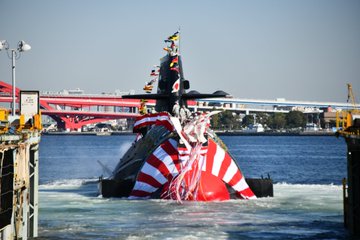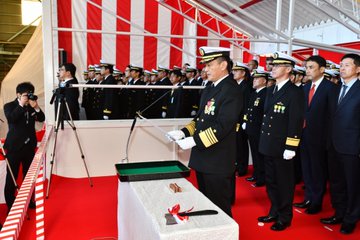
If you’re reading this article on your mobile phone, then you know that your mobile phone is running on lithium-ion battery. The Soryu class uses the same battery cell to propel itself in the depth of the ocean quietly, not letting the adversary know the location of the Soryu class. The quieter a submarine is, the harder is to detect the acoustic sounds!
Japan’s Kawasaki Heavy Industries (KHI) built Soryu-class diesel-electric attack submarine (SSK) for the Japan Maritime Self-Defense Force (JMSDF) equipped with lithium-ion batteries. The Soryu-class’s capabilities include anti-surface, anti-submarine warfare, mine laying and reconnaissance missions.
Read More Japan Ends Arms Exports Ban, but Who wants to Buy?
Japan is the first country in the world to equip attack submarines with lithium-ion batteries in place of lead-acid batteries, due to the lithium-ion’s capability to store much more energy.
According to Jane’s Fighting Ships , the Soryu class has a beam of 9.1 m, a hull draught of 8.4 m, and a displacement of 2,947 tonnes when surfaced and of 4,100 tonnes when submerged. Each of the platforms has a top speed of 20 kt when submerged and of 12 kt when surfaced. The Soryu class has a range up to 6,100 miles at 6.5 knots. The submarine can accommodate 65 crews and sailors. The maximum diving depth of the sub is around 650 meters.
Read More Royal Australian Navy’s Shortfin Barracuda Class Submarine
On 12 November, KHI launched the 12th and final Soryu-class SSK on order for the JMSDF. The boat is also the second of the class to be equipped with lithium-ion batteries. The 84 m-long boat, which has been named Toryu (with pennant number SS 512), entered the water on 6 November in a ceremony held at KHI’s facilities in Kobe, one of Japan’s largest shipyards.
The total cost of acquiring the submarine is about JPY56 billion (USD502 million), a spokesperson at the JMSDF reported Jane’s on 18 March.
Read More Chinese Type 094 Submarine in Embarrassing Incidents In South China Sea
Toryu is also the 12th and final submarine of the Soryu class and the sixth to be built by KHI, with the other six having been built by Mitsubishi Heavy Industries (MHI). The boat was laid down in January 2017 and is expected to enter service with the JMSDF in March 2021.
At the time the company said the batteries, which store considerably more energy than the lead-acid batteries, would be mounted on the final two Soryu-class boats for the JMSDF: SS 511 ( Oryu ), and SS 512 ( Toryu ).
Sensors and Sonar
The Soryu class is equipped with ZPS-6F surface search radar, bow mounted ZQQ-7 sonar suite, towed array sonar, four LF flank arrays, ZLR-3-6 ESM, acoustic countermeasures and decoys.
Next to bow-and-flank-mounted Hughes/Oki ZQQ-7 sonar arrays, the sub is also equipped with a towed array sonar capable of detecting ships over 70 kilometers away.
Hybrid Propulsion
For silent running, each submarine is equipped with twelve Kawasaki 12V 25S diesel generators, one tandem Toshiba electric motor and four Kawasaki Kockums V4-275R Stirling air independent propulsion systems licensed from Sweden that can power the submarine underwater for up to two weeks.
The addition of lithium-ion batteries to diesel-electric submarines provides a hybrid propulsion capability of sorts. Submarine stealth relies primarily on a low-observable acoustic signature; simply put, submarines need to be quiet to be undetectable by sonar. Moving components in diesel-electric engines generate undesirable vibrations that reduce the stealthiness of submarines.
The launch comes after GS Yuasa, a Kyoto-based developer and manufacturer of battery systems, announced in February 2017 that Japan would become the first country in the world to equip SSKs with lithium-ion batteries in place of lead-acid batteries.
Use of Lithium-ion Batteries
Lithium ion batteries aren’t a risk-free technology. Lithium catches fire when exposed to water, a precarious situation for a submarine. In the event of a leak, the batteries must be shielded from water at all costs. Lithium fires are hot, burning at up to 3,600 degrees Fahrenheit, and release hydrogen gas. Hydrogen gas buildup on submarines is very bad, because a submarine is a small, enclosed space and hydrogen gas is flammable. A hydrogen gas buildup is one theory behind the sinking of the U.S. Navy submarine Scorpion.
- Submarines use batteries for quiet propulsion underwater.
- Until recently, submarines used lead acid batteries, which were heavy and less energy efficient.
- The adoption of lithium ion batteries is a huge improvement over the older batteries but carries some risks.
Despite the risks of using lithium ion, Japan obviously thinks the reward in terms of increased submarine performance is worth it. Other navies will inevitably follow suit, resulting in a new generation of submarines that are deadlier than ever.
Armaments
The Soryu class is equipped with six 533 mm bow tubes that can fire the Japanese-developed Type 89 heavy-weight torpedo. The boats are also capable of deploying the UGM-84C Harpoon medium-range anti-ship missile against surface targets.
Upgrade Plan
Japan’s submarine fleet is getting a major upgrade, and it’s likely the same tech found in the device you’re using to read this article. The new submarine Toryu, or “Fighting Dragon,” is equipped with lithium ion batteries, which power most of the consumer technology available worldwide. The result is submarines capable of cruising silently underwater longer than ever.
Not all diesel-powered submarines use batteries to travel silently underwater. Japan is the leading nation to adept to the challenging technology. The batteries are charged by the diesel engine, which needs oxygen to run. This in turn requires the submarine to surface, or at the very least snorkel, which exposes the periscope, an air intake, and an exhaust port above the surface of the water. Although small, these bits of equipment can be detected by radars, bringing unwanted attention from enemy anti-submarine ships and planes.

Some modern submarines use an air independent propulsion system instead of regular diesel engines to travel underwater and recharge their batteries. This increases the amount of time a submarine can travel underwater, but it’s noisier than battery propulsion. The better the batteries, the longer a submarine can travel—and fight—underwater.
Since World War II, submarines have used lead acid batteries. Lead acid batteries are heavy, but they’re also a proven technology. They’re also obsolete in the consumer world, replaced in the 1990s by nickel metal hydride batteries. Today’s devices are powered by an even better technology, lithium ion batteries.

Toryu, built by Kawasaki Heavy Industries and launched on November 6th, is equipped with lithium ion batteries. Lithium ion batteries are lighter and have a higher energy density, meaning a pound of lithium ion batteries will store more electricity than a pound of lead acid. Lithium ion batteries also hold their charge longer and are faster to recharge. Toryu will be able to sit quietly on the bottom of the ocean, waiting in ambush for the enemy fleet, then sneak away on battery power after it unleashes a salvo of torpedoes.
Exports
“New Delhi has forwarded ‘a proposal’ to Tokyo to ‘consider the possibility’ of making its latest diesel-electric Soryu-class submarines in India,” Times of India reported, citing unnamed sources.
Japan declined to participate in the Project 75I of Indian Navy to make Soryu-class for Indian Navy citing lack of strong security mechanism in India especially cybersecurity and data protection for defense technology. The foreign OEM’s concern of sharing their sensitive tech with India. India so far failed to keep secret documentation of French-built scropene submarine and recently, Indian media leaked documentation related to Rafale Fighter Jet to name a few.
With the recent leak of scorpene class submarines technology, they become rather more defensive towards transfer it. Also there is repeated claim that cyber attacks from china to India has given lot of critical information and poor cyber security infrastructure of India is unable to even detect a attack.
After lifting of sanction by PM Shinzo Abe and recent improvement in friendly relation between India and japan has created hope for India to achieve such technology, but it is highly unlikely that India will get such submarine in the near future unless it upgrade its cyber security infrastructure and intelligence unit.
Kawasaki Heavy Industries lost $50 billion dollars bid to rival France’s Naval Group’s to build submarines for Royal Australian Navy. Australia has awarded $50 billion dollars contract to Naval Group to build submarines for Royal Australian Navy in Australia.
© 2019, GDC. © GDC and www.globaldefensecorp.com. Unauthorized use and/or duplication of this material without express and written permission from this site’s author and/or owner is strictly prohibited. Excerpts and links may be used, provided that full and clear credit is given to www.globaldefensecorp.com with appropriate and specific direction to the original content.






Be the first to comment